Different types of festivals are celebrated every year in Tripunithura temple. Festivals have a great importance in this temple. Lord Subramanya killed Tharakasura and gave back Devalokam to Devas. Devas worshipped Subramanya and celebrated a festival to mark his victory. But Subramania said that the war was won by the combined effort of Devas and not by him. He ordered festivals for all Devas and fixed pattern for main Devas. It is believed that festivals are conducted on the basis of this order and finally they took the present form.
The festival is for the prosperity of the whole village and all should participate in it. Festival brings the blessings of God and growth in all fields. Festivals are of three types. They are Anguradi, Dhwajadi, and Padahadi and they are ranked as the best, Medium and lowest in the same order. Anguradi begins with “Mulayidal”. Dhwajadi begins by hoisting the flag on post. Padahadi begins with the sound of drums. Sometimes flag is also hoisted in Padahadi.
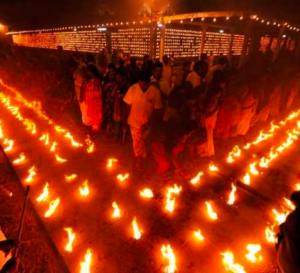
It is conducted in memory of the fire incident in the temple on 9/3/1096 (Malayalam). There are no important rituals for this festival. Camphor and lights are lighted throughout the temple memory of fire. In Tripunithura temple Vrichikam festival is Anguradi. Chingam festival is Dhwajadi and Para festival is Padahadi.
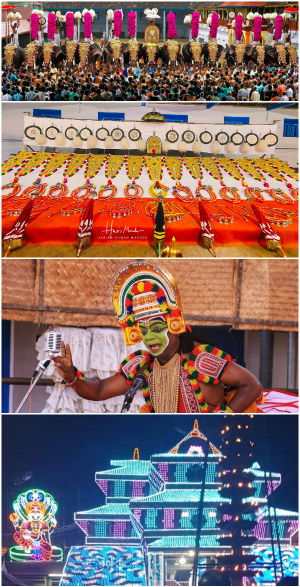
It is an important festival of the temple conducted in the Malayalam month Vrichikam (November – December). It begins on the star Chothy and ends with the star Thiruvonam. The festival is conducted jointly by Devaswom and Upadesaka Samithi. It is celebrated on a large scale along with proper Thanthric rituals. This is a national festival not restricted to the level of a temple festival. It is celebrated by one and all irrespective of caste, creed or religion. People from all walks of life co-operate and receive the blessings of Poornathrayeesa. Fifteen decorated elephants are used in the morning and evening functions. Panchari Melam produced by the most popular artists is a sumptuous feast for all lovers of art. Panchari Melam of Tripunithura is famous throughout the country just like “Pandi Melam” of Thrissur Pooram. The music from the wind instrument “Kurumkuzhal” on the day of star “Thrikketta” is highly appreciated by all. The temple atmosphere is always filled with music concerts, Kathakali, Ottamthullal, and different forms of dance including folk dances and other types of competitive activities. Fireworks are not important for the festival because it is believed that loud noise is not liked by the Lord. Elephants and their procession are most liked by the Lord and the expense is shared by many as an offering to Poornathrayeesa. This is a special offering for the long life, prosperity and education of children. The fruits offered during “Para” festival is given to elephants as a mark of attachment to elephants. Both people and elephants enjoy taking sweet food. This happiness will please the Lord. The important days of the festival start on the day of star “Thrikketta”. Vilwamangalam who reached the temple on that day found that God was not present in Sreekovil. When the Swamiyar came out, procession of elephants had already started. He saw children playing on the elephant and the Lord was deeply involved in this play. The Lord sitting on the elephant blessed Swamiyar. The children playing on the elephant may be the children of Santhana Gopala Brahmin or the Gopala of Vilwamangalam, God only knows. Remembering these holy instance devotees worshipped the Lord on the elephant and returned after getting his blessing. It is believed that worshipping the Lord on this auspicious day is equivalent to worshipping him for the whole year. This belief increased the number of devotees visiting the temple on this day and the festival became more popular and attractive. Devotees worshipped the Lord encircled by the dazzling brilliance of gold and diamonds seated on the elephant. They drop money and other items into the gold vessel as offerings and return with increased devotion and happiness. Most of the oil lamps of the temple are lighted during festival days Sreekovil and other important holy spots are decorated with flowers. Light from the huge bronze lamp post on the eastern side fills the hearts of all devotees with happiness. The illumination of the whole temple is a sight which will stick to the mind. Lighting the temple lamps is considered to be a sacred ritual.
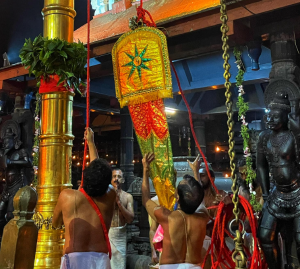
Moosari festival is also called Chingam festival. It starts from the star Chothy and ends with Thiruvonam in the Malayalam month Chingam (August – September). Even though there is flag hosting, rituals are minimum for this festival. This festival is only of recent origin. There is a story related to this festival. Some people believe that the idol was thrown into pond and the temple damaged partially during the attack of enemies. This idol was later taken out and installed in the temple. Another version is that the rulers of the temple decided to make a new idol when the old one was damaged either by the attack of enemies or in the course of time. A silpi from Mulamthuruthy was entrusted with the work of casting the idol. Metals like gold, silver, copper, tin and iron in proper proportions were handed over to the silpi for making the idol in Panchaloha. Unfortunately the silpi failed in the casting job repeatedly. People began to scold him and he was very sad. He did not know the reason for his failure. Finally after pouring the molten metal in the mould, he embraced it requesting Lord’s blessing for the successful completion of his duty. The silpi being a pious soul joined the Lord during his sacrifice of embracing white hot metal. Nobody has seen the silpi afterwards. Rulers started this festival in memory of the liberation of the soul of silpi. We have already noted in the section “order of worship” that the silpi is remembered and is given a place in the temple.
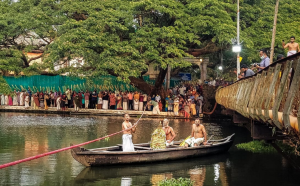
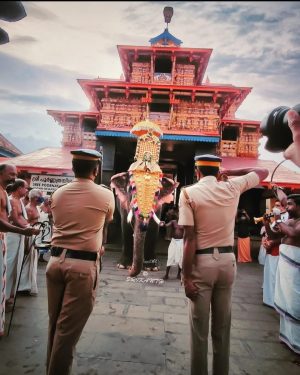
This is also called the Festival of Nangapennu celebrated in the Malayalam month Kumbam (February – March). There is also a colourful story related to this festival, narrated by Kottarathil Sankunny of Udayamperoor. “Nanga” was the daughter of a Namboodiri. She was beautiful and intelligent. The family members of this girl were devotees of Poornathrayeesa. She was the pet child of the family. Along with her mother she worshipped Poornathrayeesa daily without any break.
Her marriage was fixed at the age of 12. The bride-groom was a handsome educated and well behaved youth who resided at a faraway place from the temple. All were happy about the marriage proposal and they made arrangements for the marriage. But the girl was not happy because it is not possible to worship Poornathrayeesa daily by coming from the husband’s house. She was highly worried and always thought of the Lord to get a solution for her problem. She visited the temple daily and prayed to the Lord. Parents did not know the reason for her sorrow. She always wept in front of the Lord. The tears filling the eyes of this innocent girl were noticed by the Lord. She came to the temple on the previous day of her marriage and could not control herself because it was the last day of her visit to the temple. She wept and said “I want to come to the temple daily. If I am given in marriage I cannot live without this light, if this daily visit is not possible I will end my life. Show mercy and please save me. In the next moment a holy brilliance fell on the girl. She felt that the Lord was calling her. She ran into the Sreekovil and was embraced by the Lord. She was immersed in eternal bliss and joined the Lord. Nobody saw the girl afterwards. The festival in the month of Kumbam (February – March) was started in memory of this incident. Even today the Lord visits the house of this girl once during this festival. New dress is offered to the family members of the girl after the pooja and feast. This function is similar to the case of a bridegroom visiting the bride’s house.
Historians treat this in a different way. They consider this incident as a story to combat the development of Budhism and Jainism. The Brahmin girl and silpi of lower caste are equal to God and they became one with God. A devotee irrespective of cast or religion can have eternal bliss and oneness with the Lord if he surrenders with full faith. According to historians this may be a story to attract people towards Hinduism. Anyhow we do not want to go deep into this conclusion which is against the belief of sincere devotees.
This festival (Para festival) extends from Chothy to Thiruvonam of the month Kumbam. There are lands belonging to Tripunithura Devaswom in different parts of the country. These are lands offered by devotees to the Lord at different times. A portion of the agricultural products obtained from these lands are given to the temple. This increased the prosperity of the temple. This was the beginning of giving lands on lease. There is no Raja bhogam (tax) for the land owned by temples.
During the “Para” festival different items like paddy, rice, fruits etc are offered to God and the donors are blessed by Him. This festival is after the harvest month Makaram. The idol is taken to different houses for this festival. Later when the number of houses increased beyond a limit visiting the houses was stopped. Being a time bound festival they cannot increase the number of days for covering more houses. Now the idol is taken through main streets and people fill the Para in the street in front of their houses. In some important places the idol is taken inside to perform pooja. There is special appam Naivedyam at Poonithura palace and Thiruvamkulam temple during the pooja of the idol.
The law enabling all Hindus to enter temples came into effect first in Travancore and then in Cochin.
In olden days the procession carrying the idol used to enter places in Travancore during “Para” festival. The entry into Travancore area was stopped when all Hindus began entering temples. It is also believed that the Travancore area was avoided to cut short long journeys. The real reason for restricting para to the Cochin area is not known.
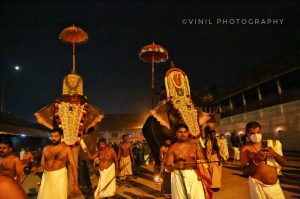
Lord Siva of Perumthrikovu temple visits Poornathrayeesan on “Thiruvathira” in Dhanu (December – January). Siva is the guest of Narayana on that day. This shows that Sankara and Narayana are one and the same and we have the concept of “Sankara Narayana”.
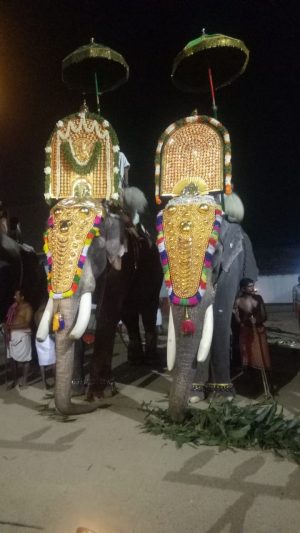
Devi of Pisharikovil in Eroor visits the Poornathrayeesa temple on the day of star “Uthram” in Kumbam (February – March). Poornathrayeesan welcomes the Devi. Pooja and other rituals are performed for the Lord and Devi together. Worship of both the idols (Lakshmi & Narayana) on that day is good for the strong relationship of couples.
The birthday of Poornathrayeesa is Uthram in the month Kumbam (February – March). The devotees arrange a grand birthday feast and light lamps on that day. Appam Naivedyam on that day is a special prasadam for prosperity and child birth. This special Naivedyam is submitted to the Lord by the lower poojari with the permission of Bhattathiri. It shows that separate sanction is needed to submit a special Naivedyam.

